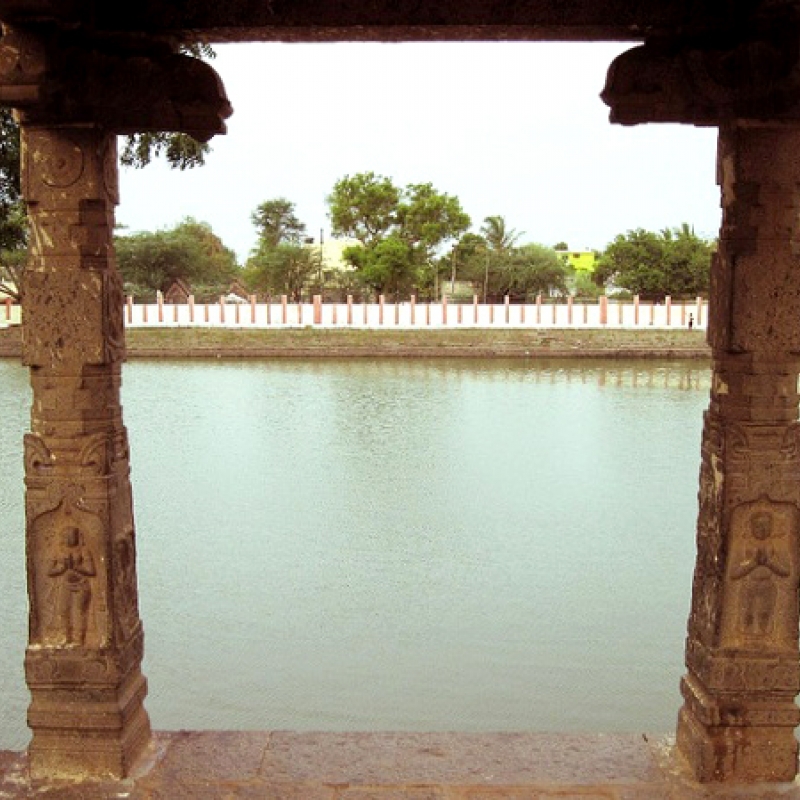Water, a limited though renewable resource, is the thread that weaves the fabric of life on earth. About 95 per cent of all life on earth is aquatic and all forms of life in the natural world depend on water for their survival. We live on a blue planet. When viewed from space, we see 75 per cent of the earth’s surface covered by the oceans. However, water that is fit for consumption is neither evenly distributed on this planet nor available in every corner like air. Freshwater is around three per cent of earth’s total water, less than one per cent of which flows as rivers and streams that serve most of life’s needs.[1] Rain, one of the key aspects of the earth’s water cycle, is an important source of freshwater and pours from the clouds, flows in rivers, collects in ponds and lakes, sinks through the porous soil and recharges underground aquifers.
Distribution of Earth’s Water
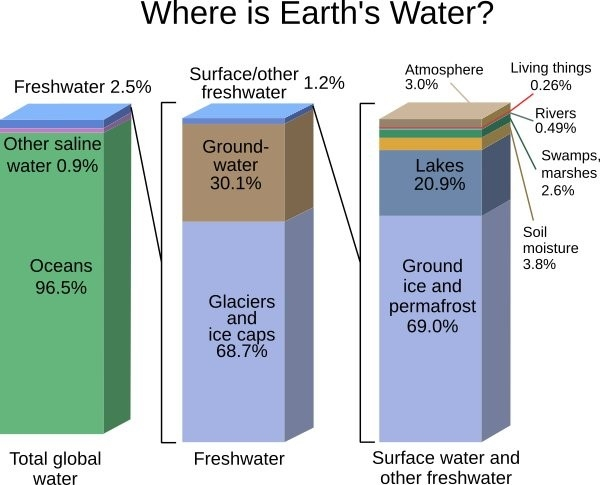
- Only three per cent of water on the surface is fresh
- 97 per cent is salty and is in the oceans
- Of the total freshwater, 69 per cent is found in glaciers, 30 per cent underground, and less than one per cent in lakes, rivers and swamps
Looked at another way, only one per cent of the water on the earth’s surface is usable by humans.
Groundwater is a finite resource and the current unsustainable use by humans, without sufficient recharge, is leading to rapid depletion of these aquifer systems. Increase in water pollution, construction of big dams and loss of green cover is creating massive stress for ecosystems, resulting in erratic monsoons and general rise in temperature. For many centuries, communities across the world have managed their local water systems. India, through the ages, has built diverse and numerous water harvesting structures ranging from temple ponds, wells to small dams and lakes. In some parts of the country, where the bulk of the monsoon rain falls for only a few weeks, people harvested the water in these structures allowing autonomy and self-reliance in their water needs.
In this study, we shall look at rainwater harvesting structures from different periods in the history of India, and some that are functional up to this day. Additionally, we will see that by reviving and adapting these different systems to the present context, they can ease today’s water-stressed areas significantly. For example, Piyush Manush (2017), an environmental activist in Salem, brought together a group of people and adopted a 58 acre lake. Piyush and his team cleaned the lake, and with the help of machines formed 45 islands on it and planted several species of trees there. Today, in addition to being a freshwater source, it is widely used as a public space and is also a wonderful haven for numerous migrating bird life.
The revival of water bodies encourages afforestation, reduces soil erosion, increases the rainwater catchment area and strengthens groundwater absorption which is of vital importance in our current times.
India’s Water Wealth
India has about four per cent of the world’s freshwater and 17 per cent of the world’s population.[2] In 2015, NASA’s satellite data showed that 21 of the world’s 37 large aquifers are severely water-stressed. The study found that the Arabian Aquifer System, an important water source for more than sixty million people, is the most overstressed in the world. The Indus Basin Aquifer of north-western India and Pakistan is second and the Murzuk-Djado Basin in northern Africa comes third.[3] With growing populations, climate change and increased demands from agriculture and industry, researchers indicate that this water crisis is only likely to worsen.
So how are we to make available this essential fluid in order that all nature and humans can access it on a regular and secure basis?
Importance of Waterbodies in Histories, Rituals and Myths
All traditions across the world have a special reverence for water. Very broadly, water is considered a purifier in many religions. Holy water, water deities and baptism in rivers encompass a deeper story in traditional societies where it is often merged with devotion to the divine. These stories birth the responsibility and enhance the man–nature relationship with water, which in many ways has been the crux of the long-term survival of traditional and indigenous societies.
According to Jewish mystical tradition, Shekinah, the female companion of God, is said to have ‘moved on the face of the waters’ during the creation narrative of the world.[4] It is said she came along with Adam and Eve when they left the Garden of Eden.
In the Hindu tradition, the tale of King Bhagiratha’s penance to free the souls of his ancestors, thus bringing the sacred river Ganga down to the earth from the heavens, has been told and retold from one generation to the next. One of the reasons many people immerse ashes of their kin or take a dip in the Ganges is because it is considered a wholesome act of purification and it is believed that it leads the soul to eternal liberation.
Water as a symbol of life as well as a means of cleansing, or purification, is of particular importance in the Old Testament. It was created on the first day (Genesis 1:2, 6–8). In Christianity there are numerous instances (baptism, walking on water, etc.) when Christ uses water symbolically to represent God and the life spirit.
Water plays a central role in Islam. The word ‘water’ is mentioned more than 60 times in the Quran and there are also many references to rain, snow and ice. Islam has many rituals involving water, especially that of using it to cleanse oneself before prayer.
History of Civilisations and the Beginning of Agriculture
River valleys have witnessed the birth of human settlements and some of the greatest cities in the past, which became renowned social and trading centres. Around 4500 BC, the land between the rivers Tigris and Euphrates witnessed a great river culture—the Babylonian civilisation [5] (Alkazi and Jain 1992). The creation of water systems can be traced to when humans evolved from living a hunter-gatherer nomadic lifestyle to becoming long-term settlers where they learnt to manage land and water and develop agriculture. People everywhere have universally depended on rivers and rains for their livelihoods.
Water conservation systems in India date back to before 3000 BC. Marvellous engineering features such as stone drains and rock-cut wells have been found in the excavation sites at Dholavira in Khadir Island of the Rann of Kutch (Harappan civilisation).[6] In Ganzu, one of China’s driest and poorest provinces, underground tanks, traditional water cellars and water caves can be traced back a thousand years.[7] In the Negev Desert of Israel, water harvesting systems dating back 4000 years or more have been discovered.[8]
Yet in drier areas, people depended only on rainwater or groundwater for all purposes. Unlike major river valleys where the flow of water is usually constant, rainwater harvesting is solely dependent on rain. Rainwater Harvesting (RWH) is catching the rainwater where it falls and collecting every drop.[9] Instead of allowing it to run-off, which can often cause erosion, it is harvested and utilised. In the semi-arid drought-prone areas, where water harvesting has been practised for many generations, it has become a significant productive form of soil and water conservation. Over millennia many different methods to collect as much water as possible from rainfall have evolved. This was a very common practice across the world.
Rainwater Harvesting (RWH) can also be seen as a simple form of irrigation. Rain-fed crops are directly affected if rains fail, resulting in crop failure. However, if the available rain can be collected, reasonable yields can still be achieved. A continual and efficient water harvesting system will increase green cover, conserve soil and increase the groundwater table.[10]
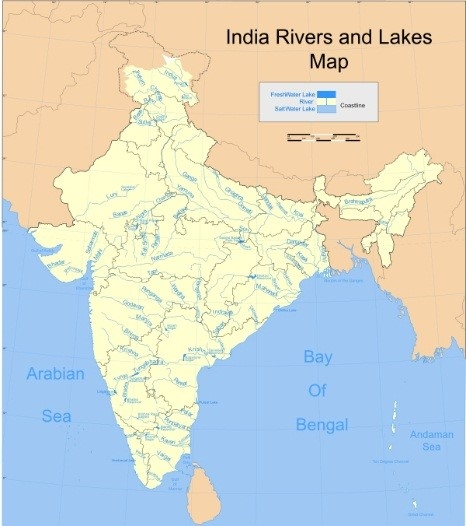
The Indian Context
Even though a complex network of rivers runs through the landscape of India allowing easy access to water, many places in India depend solely on rainfall and groundwater for their water requirements. The Indian annual rainfall pattern is first seen as the Southwest monsoon from June to September, which spreads throughout western, northern and central India, followed by the Northeast monsoon from October to December which feeds most of South India.
The volume of rainfall differs from heavy to scanty in different regions in India and is uneven in terms of timely occurrence. The average annual rainfall in India is about 125 cm. Meghalaya, in the north-east, receives the highest annual rainfall at around 1,140 cm, whereas parts of western Rajasthan record only 9 cm of rainfall in a year.
Water Harvesting in Indian History
|
321– 291 BC |
Kauṭilya’s Arthaśāstra gives an extensive account of dams and bunds that were built for irrigation during the Mauryan Empire by Chandragupta Maurya. These were managed and regulated with a clear set of rules. Severe punishments were imposed for causing damage to property by flooding, owners of higher tanks preventing the filling of the lower tank and failing to maintain the water bodies. So much so that death penalty was prescribed for breaking a reservoir or tank full of water! Different types of taxes were collected on water drawn from natural sources like rivers, tanks and springs versus water drawn from storage structures built by the king. The tax rate varied according to the method of drawing water. In the absence of the owner, the waterbodies were maintained by the people of the village (Public Health Engineering Department, Meghalaya, n.d.). |
|
First century BC |
A very sophisticated example of hydraulic engineering is found in Sringaverapura near Allahabad. It comprises of three percolation-cum-storage tanks, fed by an 11 m wide and a 5 m deep canal that was used for floodwater harvesting from the Ganga during heavy monsoons. |
|
Second century AD |
Large-scale development of lakes and well irrigation are seen during the time of the Pandya, Chera and Chola dynasties in South India. Natural depressions in the landscape were developed into large irrigation tanks. The Grand Anicut or Kallanai built by Karikala Chola across the river Cauvery to divert water for irrigation is still functional. It is the fourth-oldest water-regulator structure in the world which is still in use today (Water-technology.net 2013). |
|
Eleventh century AD |
King Bhoja of Bhopal built the largest artificial lake (65,000 acres) in India, fed by streams and springs, originally called Bada Talab (Big Pond) and now Bhojtal (Upper Lake). |
|
Twelfth century AD |
Rajatarangini by Kalhana describes a well- maintained irrigation system in Kashmir where structures exist around the Dal and Anchar lakes and the Nandi Canal (M. Matthews 2001). |
* The above tabular information is based on an online article available on http://www.cpreec.org [11]
Twelfth Century Onwards
In traditional India, water (jal), river (nadi), and rain (varun) are worshipped and considered sacred. Up to the beginning of colonial periods in the eighteenth century, much of the water was harvested and managed locally, allowing for creativity and engineering to be woven in with communal responsibility. From lakes and temple ponds to small dams and stepwells, the subcontinent built diverse and numerous water harvesting structures. Many of these structures were influenced by ancient Persian technology which came along with the successive wave of Persian invaders and with the long-established trade links with Persia and the Arabian Peninsula . In appearance, some of them are quite similar to qanāts (canal), which are still in use in rural Iran.[12] They also resemble ancient water structures used in Mesopotamia several millennia ago. However, since the advent of colonialism in the eighteenth century there has been a decline in these RWH systems for many reasons.[13] Incomplete understanding of holistic local wisdom traditions, loss of self-reliance on community-owned local waterbodies to bigger government controlled waterbodies, rapid urbanisation and the destruction of urban lakes and tanks have all played their part.
As stated before, the technology of water harvesting is not new in the Indian landscape. The evidence of water works and aspects of water technology in India is described in Arabic and Persian works. From the period of the Delhi Sultanate till the end of the Mughal period (twelfth century AD to eighteenth century AD), Indian and Persian irrigation technologies gave rise to an advanced irrigation system which brought about economic growth and also helped in the growth of material culture.
The Khalji dynasty is said to have built many canals, dykes and tanks in the Bengal region which was prone to floods. Indo-Persian writers mention that the first lake built by Sultan Iltutmish in Delhi served a variety of purposes. Similarly the Lodi kings and their nobles built many lakes. The famous tomb of Sher Shah in Sahasram was constructed inside an artificial lake. Both the lake and tomb are still intact.[14]
The famous Kundi Bhandara (underground water system), part of the water works system that was established in 1615 AD is one of the last functional systems that the Mughal rulers had constructed under the guidance of a Persian geologist Tabkutul Arz. It continued to supply water for centuries to the city of Burhanpur in Madhya Pradesh.[15]
One learns that rainwater, run-off water and flooding from rivers were all harvested by diversion through streams, lakes and the building of cisterns and wells. Each of these water work designs came into being by interweaving connections between rainfall patterns and the dryness of the land. These structures were used at both household and community levels. Therefore, different geographical terrains have had specialised ingenious structures for harvesting water.[16]
Examples of Traditional Water Management Techniques Still in Use Today
- Northern India
Kuls/Kuhls (Himachal Pradesh)
Long channels mainly found in Himachal Pradesh and in some parts of Jammu and Kashmir. The kul begins at the glacier and leads into a circular tank from where, when water is needed to irrigate the fields, a trickle of water is let out. This distribution is regulated by the villagers.[17]
Araghatta (Kashmir)
Araghattas are water wheels found in the Kashmir Valley. Also known as the Persian wheel, these wooden wheels help lift water from the river Jhelum to the complex irrigation system of canals which irrigate rice fields in the Valley.[18]
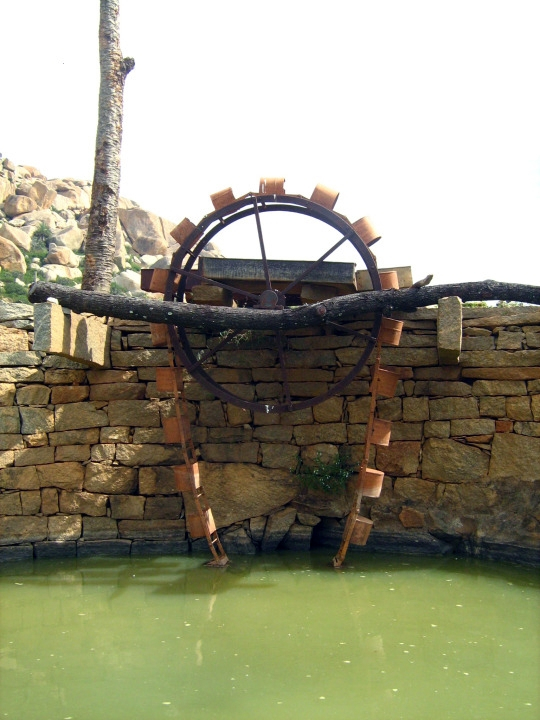
Johads (Rajasthan and Haryana)
Johads are small earthen check dams that hold rainwater, aiding groundwater recharge and slow percolation to the underground aquifer.
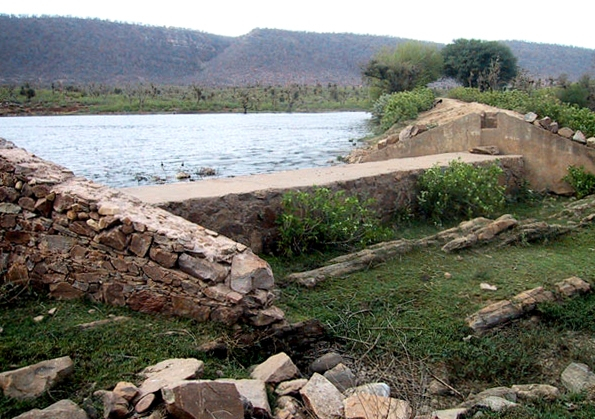
- Southern India
Kovil Kulam (Andhra Pradesh, Karnataka, Tamil Nadu and Kerala)
The tanks vary in size and shape with corridors and long flights of steps surrounding them. Intricate inlet channels bring water from a stream or river and outlets carry away the excess water.[19]
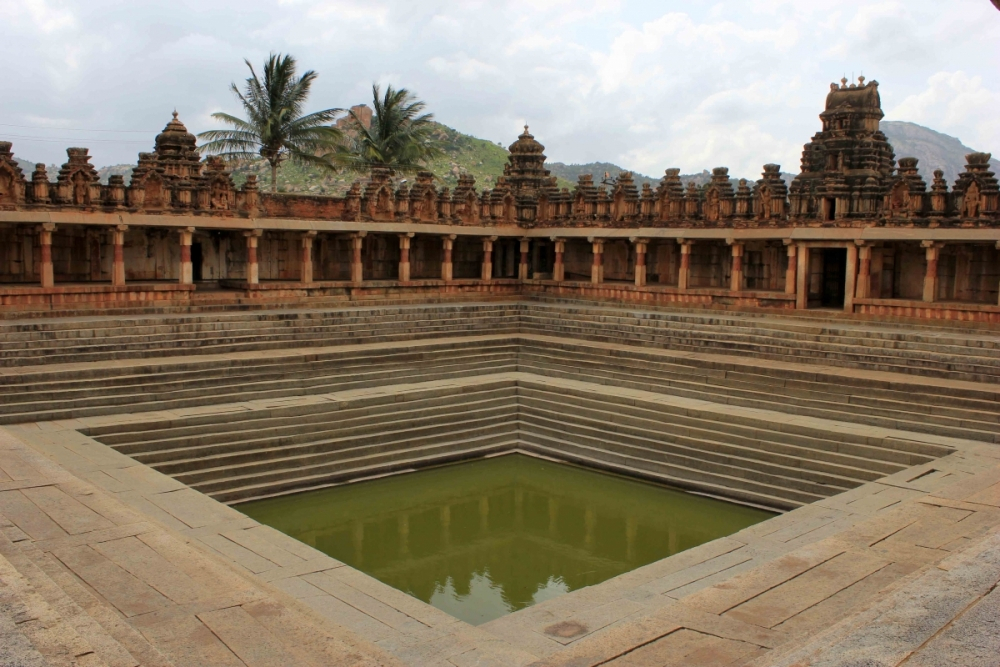
Surangas (Western Ghats)
These horizontal structures are tunnel-like wells that use gravitational force for extraction of groundwater and then collect it into a storage tank. This is then used for irrigation.[20]
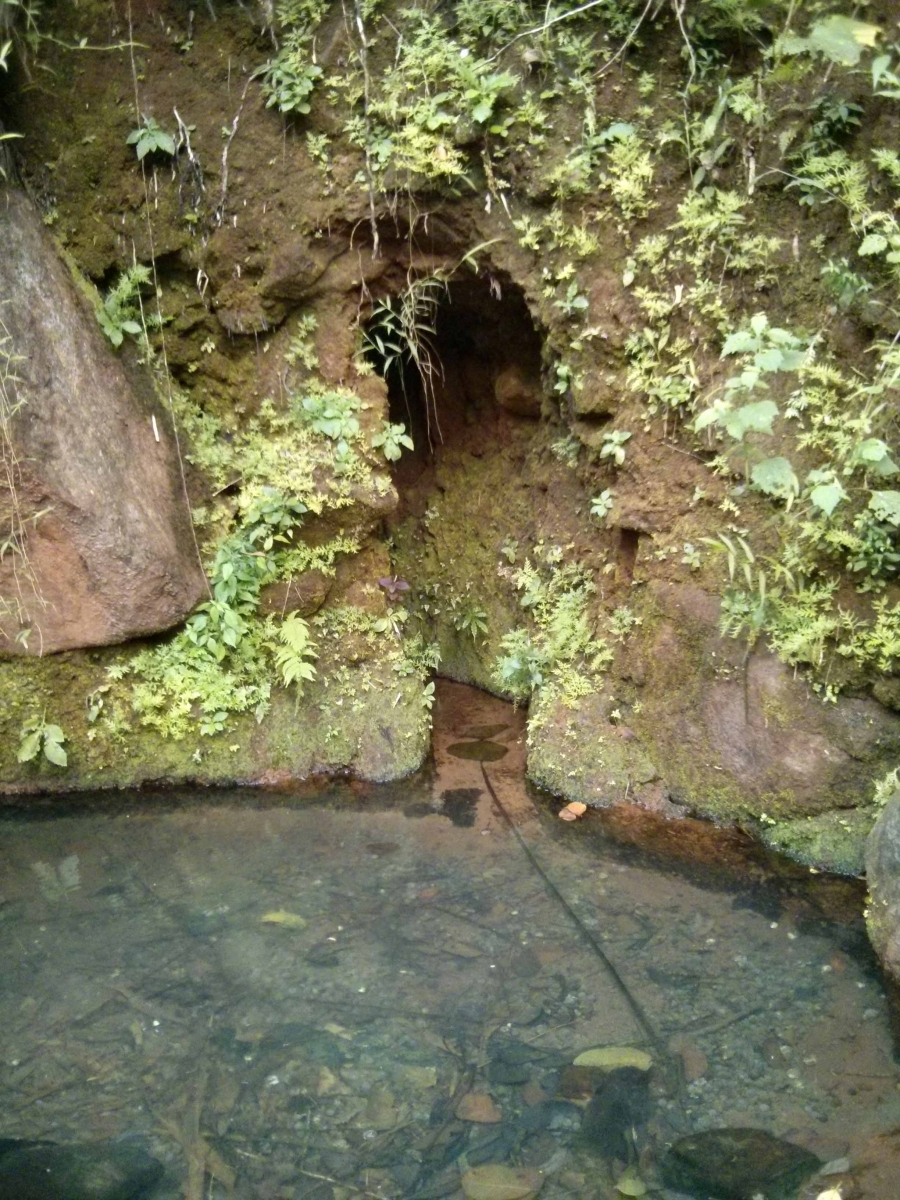
Eri (Tamil Nadu)
One of the oldest water conservation systems in India, it is still widely used across the state. Eris are fed through channels that divert river water, or rain-fed ones. They are usually interconnected to balance the water in case of excess or scarce supply.[21]
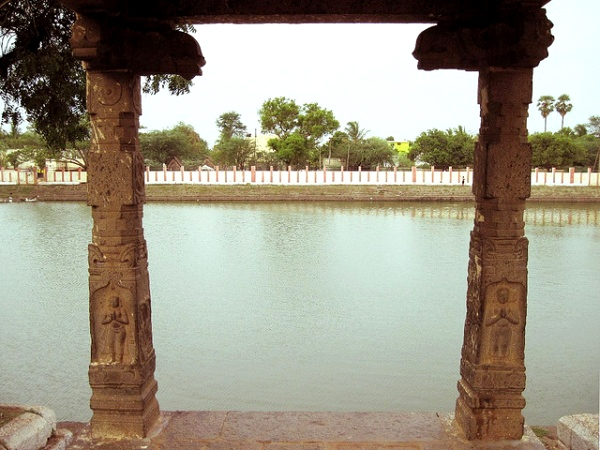
- Eastern India
Ahar Pynes (South Bihar)
Ahar is a catchment basin supported on three sides and built at the end of a canal or structures called pynes. The process starts from the river, the water then goes to pynes and eventually lands up in an ahar.[22]
- Western India
Virdas (Banni grassland, a part of Great Rann of Kutch, Gujarat)
Built by the nomadic Maldhari people. These unique structures are shallow wells,dug in depressions to collect rainwater, which separate freshwater from saltwater as groundwater is mostly saline.[23]
Kunds/Kundis (Bikaner, Jaisalmer region, West Rajasthan and parts of Gujarat)
Normally they are round and have a cover that looks like the lid of a saucepan. They are built to hold rainwater for drinking and domestic use. It is lined with lime and ash that act as disinfectants, and a wire mesh is used at the opening to prevent debris from falling in.[24]
- North-East India
The north-eastern region is one of the most ethnically diverse regions in India. Diverse indigenous water harvesting systems are prevalent here. Systems are designed with local materials making it sustainable and easy to maintain.
Bamboo drip system (Meghalaya)
This two-hundred-year-old ingenious system uses local bamboo pipes of varying length and diameter to divert perennial spring water. It is still used by the tribal farmers of Khasi and Jaintia Hills to irrigate black pepper cultivation.[25]
Zabo (Nagaland)
A centuries-old system that combines forest, land and water management with agriculture. When rain falls on terraced hill slopes, the run-off collects in ponds in the middle terrace. The runoff then passes through slopes where cattle is reared and finally reaches the paddy fields at the foothills.[26]
Recent Community Efforts
Uttarakhand:In Singoli village, community efforts have revived a spring that was dry for 20 years due to excess piped water supply. After mapping the water flow, the village community has constructed check dams to hold the water that reached the spring, thus recharging the aquifer sufficiently.[27]
Rajasthan: In 1986, Rajendra Singh began the work of reviving traditional waterbodies in Alwar, Rajasthan. After 30 years of work, more than 12,000 johads have been built, seven rivers have been revived and the region is now free from droughts and floods. This work is now encouraging communities across India to take ownership of their water resources and build more RWH structures.[28]
Madhya Pradesh: In 2010, the state government started many watershed projects to increase groundwater by building small village tanks.UNESCO recognised and accepted this as a model for the whole world.[29]
Sikkim: The Nadi festival in Shillong organised by the Asian Confluence, India, celebrated the spirit of commonality between the north-eastern states and neighboring countries through the rivers of the region. They addressed the fact that rivers are not only a source of prosperity, but are also a source of disaster. They recommended using holistic systems to manage water to mediate policy between countries.[30]
Examples of Governmental Support and Regulations
Kerala: Drought in water-rich Kerala has made the government scale up the well recharging programme called Mazhapolima (Rain Bounty) to all parts of the state. Since 2008, in Thrissur, more than 25,000 well water recharge structures have been installed in residential localities, institutions and government buildings.[31]
Tamil Nadu: It is now mandatory for all the existing and new buildings to provide rainwater harvesting facilities and to include rooftop rainwater harvesting structures in the plan of the building itself for approval by the relevant authority.
Karnataka: In Bidar, the tourism department is funding restoration work of medieval structures and has identified the conservation of Naubaz Karez as one of its projects. Kere Sanjeevini (‘life-giving lakes’) scheme and Koti Vriksha Andolana (‘campaign for one crore trees’) are government schemes.[32]
In addition, with a growing population and increasing water demands, the use of technology and advancement of science can provide solutions which address water issues. There are numerous small- and large-scale new water solutions available in the global market.
New Technology for Water Woes:
Use of Nanotechnology: Researchers in India have come up with a low-cost water purification system which removes microbes, bacteria and other matter from water using nano particles. This low-cost water purification system may be made available widely.
Intelligent irrigation: Approximately 70 per cent of the world’s freshwater is used by the agricultural industry. Highly accurate irrigation system with computer algorithms and modeling is showing benefits to farmers in developed countries.
Mobile water purification: A Danish company has come up with a portable drinking water purification unit that can run on any given power source.
*The above information is based on an article by Will Henley (2013) available online.[33]
Crisis and Opportunity
‘Water holds the key to sustainable development. We need it for health, food security and economic progress.’
—Ban Ki-moon, Secretary-General of the United Nations (UN News Centre 2013)
These were the first remarks at the Budapest Water Summit in 2013. Water management, whether it is for drinking water, irrigation or for the disposal of waste, needs to be managed. Today the water crisis is bigger than the oil and energy crisis. With climate change bringing erratic monsoons, rise in water-intensive farming techniques and rapid urbanisation, the crisis is widespread and of global concern.
If the previous century witnessed nations battling over petroleum resources, this century witnesses turbulence over water resources. The Cauvery row between Karnataka and Tamil Nadu, the pollution of the Yamuna and big hydro projects being built across the northern mountain states is causing conflict between communities over the sharing of water. Water wars, which was a prediction a few decades ago, are now becoming a reality, with the sad loss of local people managing their own water. This century’s millennials have experienced extremes of poverty and abundance: on one hand, running water is available in taps, for swimming pools and manicured green lawns and on the other hand, people stand in long queues to fill one bucket of water for the family, which is not always available every day.
The current water facilities that governments provide might increase these extremes, leading to more conflict and suffering for many people. However, these mechanised or large water distribution systems form only a few chapters in the bigger historical book of hydrology that encompasses wisdom and knowledge traditions that we can draw from for many hundreds and thousands of years. Elaborating on some traditional techniques and community efforts is merely a mirror to look back and learn. This does not mean that one rejects modernity entirely, but reminds us that for centuries we have managed water as a human species.
One can see that only one particular solution is not applicable to different areas of the country. Sometimes, traditional time-tested ways can help fulfill the requirements of people in a much more effective way. All these historically tried and tested water management systems in India are waiting to be utilised, enhanced and redeveloped within the current modern paradigm. By reviving local and contextual education, and assisting the local communities, the restoration of traditional water management systems could eventually easily lead to better water security for many rural and urban populations throughout the length and breadth of India.
Notes:
[1] Perlman, Howard. n.d. ‘Where is Earth’s water?’ Online at: https://water.usgs.gov/edu/earthwherewater.html (viewed on May 6, 2017).
[2] India-WRIS (Water Resources Information System of India). 2011. ‘India’s Water Wealth.’ Online at: http://www.india-wris.nrsc.gov.in/wrpinfo/index.php?title=India%27s_Water_Wealth (viewed on May 9, 2017).
[3] NASA-JPL (Jet Propulsion Laboratory). 2015. ‘Study: Third of Big Groundwater Basins in Distress.’ Online at: http://www.jpl.nasa.gov/news/news.php?feature=4626 (viewed on April 3, 2017).
[4] Matthews, C. 2006. The Blessing Seed, A Creation Myth for the New Millennium. Singapore: Tien Wah Press.
[5] Alkazi, Feisal, and Priti Jain. 1992. Exploring The River Front of My Town. New Delhi: Centre for Environment Education.
[6] Permanent Delegation of India to UNESCO. 2014. ‘Dholavira: A Harappan City.’ Online at: http://whc.unesco.org/en/tentativelists/5892/ (viewed on May 6, 2017).
[7] Zhu, Qiang, John Gould, Yuanhong Li, and Chengxiang Ma. 2015. Rainwater Harvesting for Agriculture and Water Supply. Singapore: Springer Singapore.
[8] Fao Corporate Document Repository. n.d. The Basis of Water Harvesting: History and Perspectives. Online at: http://www.fao.org/docrep/u3160e/u3160e03.htm#TopOfPage (viewed on May 6, 2017).
[9] Palmbach, John. 2004. ‘Traditional water harvesting.’ Online at: https://academic.evergreen.edu/g/grossmaz/palmbajp/ (viewed on May 6, 2017).
[10] Fao Corporate Document Repository. n.d. The Basis of Water Harvesting: History and Perspectives. Online at: http://www.fao.org/docrep/u3160e/u3160e03.htm#TopOfPage (viewed on May 6, 2017).,
[11] CPREEC (C.P.R. Environmental Education Centre). n.d. Online at: http://www.cpreec.org/pubbook-traditional.htm (viewed on April 5, 2017).
[12] Nair, G.S. Unnikrishnan. 2016. ‘Traditional wisdom in harvesting water,’ Journal Of Traditional and Folk Practices 02, 03 & 04(1).
[13] Raghavan, Sekhar. 2009b. Online at: http://www.indiawaterportal.org/articles/rainwater-harvesting-india-traditional-and-contemporary (viewed on April 2, 2017).
[14] Siddiqui, Iqtidar Husain. 1986. ‘Water Works and Irrigation System in India During Pre-Mughal Times.’ Journal of the Economic and Social History of the Orient, 29(1): 52–77.
[15] Pangare, Ganesh. 1992. ‘Mughal system still supplies water at zero cost.’ Online at: http://www.downtoearth.org.in/coverage/mughal-system-stilll-supplies-water-at-zero-cost-30245 (viewed on April 13, 2017).
[16] Raghavan, Sekhar. 2009a. Online at: http://www.indiawaterportal.org/sites/indiawaterportal.org/files/Traditional%20rainwater%20harvesting%20in%20India_Shekhar%20Raghavan_Akash%20Ganga%20Trust.pdf (viewed on April 2, 2017).
[17] Moudgil, Manu. 2014. ‘Kuhl, kohli and a lost tradition.’ Online at: http://www.indiawaterportal.org/articles/kuhl-kohli-and-lost-tradition (viewed on May 10, 2017).
[18] Hindustan Times. 2017. Online at: http://www.hindustantimes.com/india/jammu-and-kashmir/story-4h0s8RfOTumjmgneOdv5FN.html (viewed on April 13, 2017).
[19] CPREEC (C.P.R. Environmental Education Centre). n.d. Online at: http://www.cpreec.org/pubbook-traditional.htm (viewed on April 5, 2017).
[20] Kelker Khambete, Arti. 2010. ‘Surangas, the disappearing lifeline of the farmers of Kasargod, Kerala’. Online at: http://www.indiawaterportal.org/articles/surangas-disappearing-lifeline-farmers-kasargod-kerala (viewed on April 15, 2017).
[21] Geography and You. n.d. ‘Ten Traditional Water Conservation Methods Still in Use.’ Online at: https://www.geographyandyou.com/climate-change/water/ten-traditional-water-conservation-methods/ (viewed on May 5, 2017).
[22] ibid.
[23] Agrawal, Rakesh. 1995. ‘Water of life.’ Online at: http://www.downtoearth.org.in/coverage/water-of-life-28919 (viewed on April 6, 2017).
[24] Rainwaterharvesting.org. 2017. ‘Rural Water Harvesting’. Online at: http://www.rainwaterharvesting.org/Rural/Rural.htm (viewed on March 19, 2017).
[25] ibid.
[26] Dewani, Usha. 2014. ‘Zabo: The art of impounding water.’ Online at: http://www.indiawaterportal.org/articles/zabo-art-impounding-water (viewed on April 10, 2017).
[27] Lokgariwar, Chicu. 2015. ‘Barefoot hydrogeologists: The next generation’. Online at: http://www.indiawaterportal.org/articles/barefoot-hydrogeologists-next-generation (viewed on April 16, 2017).
[28] Frances, Philip. 2017. ‘We Can Cure Our Water Woes,’ Eternal Bhoomi 29: 12.
[29] Rawat, Bhim 2017. ‘Inspiring Water Tales,’ Eternal Bhoomi 29: 20.
[30] Nayak, Ajay. 2017. Connecting Beyond Boundaries: Nadi Festival. Eternal Bhoomi, 29: 26.
[31] Warrier, S Gopikrishna. 2016. ‘Drought in water-rich Kerala compels the state to start taking conservation seriously.’ Online at: https://scroll.in/article/825162/drought-in-water-rich-kerala-compels-the-state-to-start-taking-conservation-seriously (viewed on April 16, 2017).
[32] Sridhar, Lalitha 2017. ‘How Bidar beat back the drought.’ Online at: http://www.thehindu.com/news/national/karnataka/how-bidar-beat-back-the-drought/article18282462.ece (viewed on April 29, 2017).
[33] Henley, Will. 2013. ‘The new water technologies that could save the planet.’ Online at: https://www.theguardian.com/sustainable-business/new-water-technologies-save-planet (viewed on April 3, 2017).
Image sources
Fig 1: Distribution Of Earth’s Water by USGS [public domain], via Wikimedia Commons
Fig 2: Rivers of India via Wikimedia Commons is licensed under the creative commons attribution-share alike 3.0 unported license.
Fig 3: Araghatta by s.vishwanath and amitangshu acharya via Indiawaterportal is licensed under the CC BY-NC-SA 2.5 IN license.
Fig 4: Johads by Amanda Suutari via http://www.ecotippingpoints.org/
Fig 5: Kovil Kulam By Dineshkannambadi via Wikimedia Commons Is Licensed Under The Creative Commons Attribution-Share Alike 3.0 Unported License.
Fig 6: Surangams by Subin P Thomas via Wikimedia Commons is Licensed under the Creative Commons Attribution-Share Alike 3.0 Unported License.
Fig 7: Eri by Srinig, via flickr is licensed under the CC BY-SA 2.0 License.
Fig 8: Bamboo Drip Irrigation by Smadden via flickr is licensed under the Cc By-Sa 2.0 License.
Fig 9: Zabo by Usha Dewani via Indiawaterportal is licensed under the CC BY-NC-SA 2.5 IN license.
